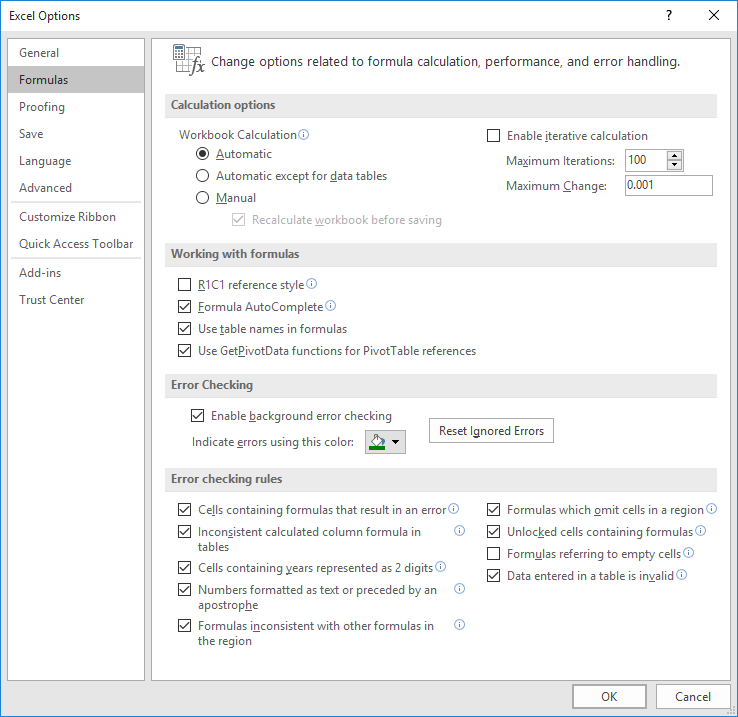Please Note: This article is written for users of the following Microsoft Excel versions: 2007, 2010, 2013, and 2016. If you are using an earlier version (Excel 2003 or earlier), this tip may not work for you. For a version of this tip written specifically for earlier versions of Excel, click here: Calculating Only the Active Workbook.
Written by Allen Wyatt (last updated May 20, 2023)
This tip applies to Excel 2007, 2010, 2013, and 2016
Linda asked if there is a way to calculate only the active workbook. When a recalc is performed by Excel, it recalculates all her open workbooks, and if they are very large workbooks it can sometimes take over fifteen minutes to recalc. If she is able to limit what is recalculated, then the process will obviously run faster.
Unfortunately, there is no direct method to just calculate a particular workbook. You can, however, calculate just the active worksheet, if desired. First, set the recalculation mode to manual by following these steps:

Figure 1. The Formulas options of the Excel Options dialog box.
Now the only time your workbook (actually, all your open workbooks) will be recalculated is when you press F9. If you want to recalculate only the current worksheet, then press Shift+F9.
Excel also provides macro functions that allow you to do any of these three things: calculate all open workbooks, calculate a specific worksheet in a workbook, or calculate a specified range of cells on a worksheet. With this knowledge you could create a macro that would loop through all the worksheets in a workbook and recalculate each of them.
The following macro sets the calculation mode to manual (so the other workbooks will not calculate) and then loops through and calculates each sheet of the active workbook.
Sub CalcBook()
Dim wks As Worksheet
Application.Calculation = xlManual
For Each wks In ActiveWorkbook.Worksheets
wks.Calculate
Next
Set wks = Nothing
End Sub
If you believe that you may want to calculate different parts of your workbook at different times, you can expand the macro so that it will perform any type of calculation you may want:
Sub CalcWhat()
Dim iAnsure As Integer
Application.Calculation = xlManual
iAnsure = InputBox("1 = Calculate A Used Range" _
& vbCrLf & _
"2 = Calculate This Worksheet" _
& vbCrLf & _
"3 = Calculate This Workbook" _
& vbCrLf & _
"4 = Calculate All Workbooks in Memory" _
& vbCrLf & vbCrLf & _
"Input Your Selection Number From Above" _
& vbCrLf & "Then Click OK", _
"Calculate What?", "Input Number Please", _
5000, 5000)
Select Case iAnsure
Case 1 'Range Only
Selection.Calculate
Case 2 'Worksheet Only
ActiveSheet.Calculate
Case 3 'Workbook Only
For Each wks In ActiveWorkbook.Worksheets
wks.Calculate
Next
Case 4 'All Open Workbooks
Application.CalculateFull
End
End Select
End Sub
This macro presents an input box that prompts the user as to which type of recalculation is desired. When the user enters a number from 1 to 4, the desired type of recalculation is performed.
Note:
ExcelTips is your source for cost-effective Microsoft Excel training. This tip (6752) applies to Microsoft Excel 2007, 2010, 2013, and 2016. You can find a version of this tip for the older menu interface of Excel here: Calculating Only the Active Workbook.

Excel Smarts for Beginners! Featuring the friendly and trusted For Dummies style, this popular guide shows beginners how to get up and running with Excel while also helping more experienced users get comfortable with the newest features. Check out Excel 2019 For Dummies today!
Creating macros can help extend what you can do in Excel. If you work with macros, you know that creating macros from ...
Discover MoreNeed to know if a particular cell is clicked with the mouse? Excel has no particular event handler for clicking in this ...
Discover MoreNeed to put together a bunch of characters to create a text string? You can do it in your macros by using the String ...
Discover MoreFREE SERVICE: Get tips like this every week in ExcelTips, a free productivity newsletter. Enter your address and click "Subscribe."
2024-03-22 12:59:37
J. Woolley
Here are Microsoft's descriptions of the calculation keyboard shortcuts, but I find them difficult to understand or confirm:
F9 – Recalculate formulas that have changed since the last calculation, and formulas dependent on them, in all open workbooks. If a workbook is set for automatic recalculation, you do not need to press F9 for recalculation.
Shift+F9 – Recalculate formulas that have changed since the last calculation, and formulas dependent on them, in the active worksheet.
Ctrl+Alt+F9 – Recalculate all formulas in all open workbooks, regardless of whether they have changed since the last recalculation.
Ctrl+Alt+Shift+F9 – Check dependent formulas, and then recalculate all formulas in all open workbooks, regardless of whether they have changed since the last recalculation.
2024-03-21 10:02:20
James Buist
The question I have here is this. If I calculate a single sheet, say sheet 1 which has references from sheet 2, will it calculate what it needs in sheet 2 before calculating sheet 1 or will it just take the current calculated values in sheet 2 and use them in the sheet 1 calculation. If the former, then your concept of looping through the sheets would work. But if not, then using this method could easily give you false results unless you recalculate the sheets in the reverse order of dependencies.
I really do not understand why MS have not got an option to recalculate a single workbook as the calculation engine does all the dependency checking and recalculates as required
Got a version of Excel that uses the ribbon interface (Excel 2007 or later)? This site is for you! If you use an earlier version of Excel, visit our ExcelTips site focusing on the menu interface.
FREE SERVICE: Get tips like this every week in ExcelTips, a free productivity newsletter. Enter your address and click "Subscribe."
Copyright © 2025 Sharon Parq Associates, Inc.
Comments